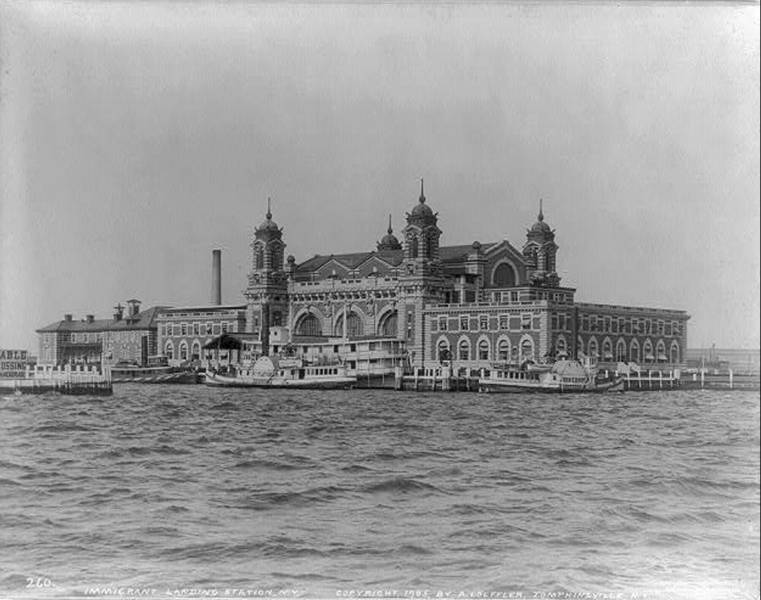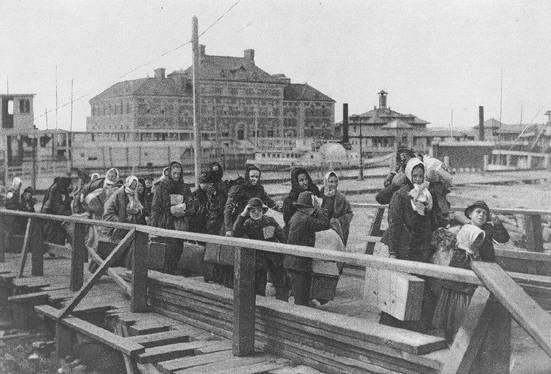Ellis Island Is Not Answer
To call America’s immigration policy an instance of “social engineering” would be too kind a judgment. As is true of the current EU policies, it was an attempt to manage the human deluge of 1880-1920, and to filter out those who might ideologically, culturally, and genetically threaten the nation. During its busiest years Ellis Island processed one million every year. The United Nations estimates about the same number are loudly knocking on Europe’s door today.
Rather than being a welcome mat, Ellis Island was a late Victorian scientific sorting machine. The only invitations the lowly steerage passengers received were from labor contractors and, if lucky, friends and relatives here who swore they would take care of them through the guaranteed bad times.
America was on the verge of greatness and Big Business and Industry needed a huge labor pool in order to grow and prosper. It was that demand that trumped Nativist xenophobia and the antagonism of a nascent, increasingly militant organized labor movement. As was true of four miserable centuries of African slave trade, it was the work and not the worker that was welcomed to the shores.
The poet in me likes to think of these competing sentiments as variations on the theme of Emma Lazarus’ 1883 sonnet “New Colossus.”
“Give me your tired, your poor, Your huddled masses yearning to breathe free, The wretched refuse of your teeming shore. Send these, the homeless, tempest-tossed to me, I need cheap labor to lower wages, inside the Golden Door!”
‘Melting Pot’ American Style
The success of the American “Melting Pot” has less to do with good intentions than with accidentally good outcomes. Rather than being the last stop on a long journey, arrival
in New York Harbor was the first step on an even longer one. Twelve million bodies passed through the Ellis Island portal their way to elsewhere. Some had no idea what lay before them but, like the shores of Lampedusa, “here” was better than “there.” I have written in several places about the Coney Island Avenue Bus I often take to Brooklyn College.
In a Voice of America program I called it a “Magical Bus.”. It begins its journey in an almost totally white upper middle class neighborhood and, most of the time, slowly moves through Afro-American, Caribbean, Mexican, Pakistani, Orthodox Jewish, and Chinese enclaves, ending in a Russian/ Ukrainian section called “Little Odessa.” As these mostly “New American” passengers embark and disembark along the route— Blacks and Whites, Latinos and Anglos, Jews and Muslims—they seldom cross ethnic lines with words or signs of mutual recognition. Frankly speaking, I don’t think they like each other very much.
American society is like this bus. From the last Great Immigration Wave that crashed upon Ellis Island to the present ebbs and flows, America has worked despite its unnatural diversity because it has unconsciously been structured in such a way that for immigrants to get what they want—prosperity, education, a decent place to live, safety and security— they must cooperate with people with whom they are different; especially with people you don’t like and who return the favor. If there is a conflict between passengers on that magical bus and people don’t cooperate they’re not going to get where they want to go. Europeans think America’s “Melting Pot” works by eliminating differences.
On the contrary, America’s immigrants learn that even though they may not be welcome, they can learn how to get to their destination without discarding the baggage they brought from home. For many years I have served as a resource for the U.S. State Department’s International VisitorsProgram. I have oftengiventours of Brooklyn neighborhoods that displaythe marvels of American diversity and, not incidentally, tolerance and cooperation among ethnic groups that could be a model for Europe.
On one occasion I took a group of junior diplomats from emerging Eastern and Central European democracies (Georgia, Romania, and Ukraine if I remember correctly) for a ride on the “Magical Bus.” The ethnic kaleidoscope stunned them. To find out the stop to transfer for their return to Manhattan
I asked a female passenger. She didn’t speak English but I recognized her Russian response. My guests all spoke Russian so one went over to get directions from her. Upon returned he admitted he was puzzled. “She speaks no English, but she told me she was an “American.”
Reasons to Worry
As everyone knows, Brooklyn is not America where more than a third of its two and a
half million residents are foreign-born. In comparison, foreign-born residents make up about an eighth of the total USA population. Also, although “minorities” comprise more than one-third of the nation they were not evenly distributed, but concentrate along its edges. Hispanics are the largest group, with 46 million persons (15% of the population). Blacks are second, with 41 million (13.5 %), followed fast-growing Asians, at 15.2 million (5%). The US Census Bureau has predicted that by 2042, more than half of the population will be minorities, with much due to immigration. Some take this as a warning.
Today it is Latinos and Muslims rather than Italians and Jews who receive the
most unwanted attention. Although not yet as menacing as France’s National Front, Germany’s Pergida, or Italy’s Northern League, “Columbia the Gem of the Ocean” has its own ugly array of white supremacists and antigovernment agitators.
Right-wing Presidential candidates call for building high walls patrolled by armed guards to keep out Latinos, and deporting hundreds of thousands of those who have contributed mightily to our economy. One of them, Donald Trump, calls for banning Muslims from entering America through any portal. Pew Research Center polls show that 46 % of Americans believe “Islam is more likely than other faiths to encourage violence against nonbelievers.” The son of America’s Evangelical icon, Billy Graham, tells his flock that it is a “religion of hatred” and “war.” As to comparative bigotry, the 2014 Pew Global Attitudes Survey found 27 % of Frenchmen, 33 % of Germans, and 63 % of Italians have unfavorable feelings towards Muslims.
It seems obvious to me that for immigrants on both sides of the Atlantic there is a big difference between getting through the “Golden Door” and being inside the house. Despite, or perhaps because, of its historic diversity America remains benevolently intolerant.





































i-Italy
Facebook
Google+
This work may not be reproduced, in whole or in part, without prior written permission.
Questo lavoro non può essere riprodotto, in tutto o in parte, senza permesso scritto.